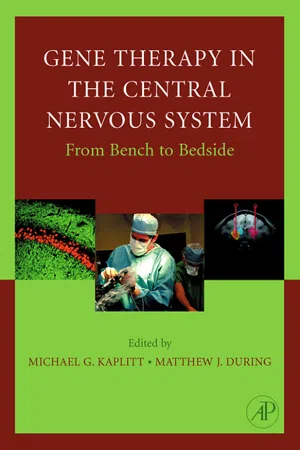
Gene Therapy of the Central Nervous System: From Bench to Bedside
- 370 pages
- English
- ePUB (mobile friendly)
- Available on iOS & Android
Gene Therapy of the Central Nervous System: From Bench to Bedside
About This Book
Few areas of biomedical research provide greater opportunities for radically new therapies for devastating diseases that have evaded treatment so far than gene therapy. This is particularly true for the brain and nervous system, where gene transfer has become a key technology for basic research and has recently been translated to human therapy in several landmark clinical trials. Gene Therapy of the Central Nervous System: From Bench to Bedside represents the first definitive volume on this subject. Edited by two pioneers of neurological gene therapy, this volume contains contributions by leaders who helped create this field and are expanding the promise of gene therapy for the future of basic and clinical neuroscience. Drawing upon this extensive collective experience, this book provides clear and informative reviews on a variety of subjects of interest to anyone exploring or using gene therapy for neurobiological applications in research and clinical praxis.* Presents gene transfer technologies with particular emphases upon novel vehicles, immunological issues and the role of gene therapy in stem cells
* Discusses preclinical areas that are likely to translate into clinical studies in the near future, including epilepsy, pain and amyotrophic lateral sclerosis
* Includes "insider" information on technological and regulatory issues which can often limit effective translation of even the most promising idea into clinical use
Frequently asked questions
Information
Design and Optimization of Expression Cassettes Including Promoter Choice and Regulatory Elements
Abstract
I INTRODUCTION
II DESIGN OF THE rAAV CASSETTE
III CELL-TYPE-SPECIFIC TROPISM OF rAAV
Table of contents
- Cover image
- Title page
- Table of Contents
- Contributors
- Preface
- Section I: Gene Transfer Technology and Regulatory Issues
- Section II: Gene Therapy for Degenerative and Functional Disorders
- Section III: Psychiatric and Behavioral Gene Therapy
- Section IV: Gene Therapy for Pain and Spinal Cord Diseases
- Section V: Gene Therapy for Brain Tumors and Neurogenetic Disease
- Subject Index